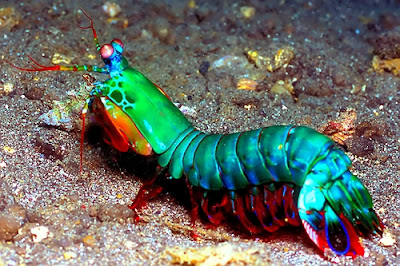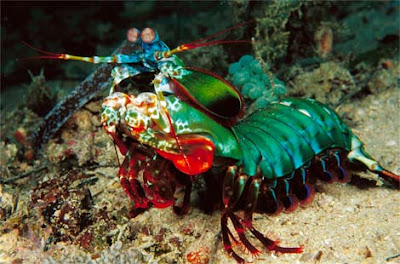Stomatopod crustaceans (mantis shrimps) possess an incredibly complex visual system, comprised of compound eyes that contain more types of photoreceptors than in any other known animal. The mantis shrimp eye’s optical arsenal includes monocular range finding capability, 12-channel colour vision, 2 channel linear polarization detection, and, in some species, the ability to detect and analyze circularly polarized light. Underlying this unparalleled array of functional capabilities is a structural diversification of a basic photoreceptive unit common to all compound eyes the ommatidium. In the following, the mantis shrimps visual prowess is described in the context of the design variations and the distribution of its ommatidia.
Mantis Shrimps shows the eye of the scaly-tailed mantis, Lysiosquilla scabricauda. It consists of upper and lower (dorsal and ventral) hemispheres separated by a narrow central band. A close examination of the eye’s surface reveals that each region consists of closely-spaced parallel rows of facets tiny ones in the hemispheres and much larger ones in the band. The hemispheres have many rows of facets but the band has only six. Looking beneath the surface reveals that each facet is the tip of an elongate structural unit, known as an ommatidium. All ommatidia are optically sensitive devices, but those in the band are the most complex, most functional, and most interesting.
The various ommatidia share certain general structural features. In particular, each ommatidium
consists of the following three sections, from top to bottom: (i) the cornea (ii) the crystalline cone (a hexagonal converging lens), and (iii) the rhabdom (rod). The rhabdom is a transparent light sensor/guide consisting of 8 photoreceptor cells a short cell (R8) sitting atop 7 long cells (R1, R2, …, R7) that are fused along a central axis. Each cell has numerous interdigitating, coplanar, finger-like constructs (microvilli) containing light-sensitive molecules. At the bottom of each rhabdom there is a conduit (axon) that conveys electrical signals to neurons. Within the framework of these general similarities, the various ommatidia have internal structural differences that give them quite different light-sensing functionalities. These will now be described.
Each ommatidium in the hemispheres is long and thin, with a rhabdom consisting of a short R8 cell on top of a ring of R1-R7 cells. There are two sets of microvilli distributed over the 8 cells. One set consists of parallel planes of coplanar microvilli, while the other set is similarly distributed in planes that are perpendicular to those of the first set. The R8 cell has both sets, but the other R1-R7 cells have one set each. This may have significance, as discussed below.
When non-polarized sunlight enters the earth’s atmosphere it interacts with atmospheric molecules and is scattered (preferentially in the blue end of the spectrum) in all directions. When viewed at an angle of 90o to the incident beam, the scattered light appears linearly polarized, meaning that the electric vector of the light wave is along a line that is perpendicular to both the incident beam and the line of sight. The sky is therefore full of linearly polarized light. Many animal species (e.g. bees, locusts) have developed an ability to use this ambient polarization to navigate even when the sun is obscured.
The parallel planes of coplanar microvilli is suggestive of sensitivity to linear polarization. The aligned light-sensitive molecules of the microvilli will sense linear polarization by oscillating only in response to electric vectors vibrating parallel to the molecule’s vibration axis. Perpendicular planes of microvilli should therefore detect light with perpendicular planes of polarization. In the R8 cell the presence of the two sets of perpendicular planes likely has a “null” effect a linearly polarized wave enters the cell, splits into two perpendicular components oscillating parallel to each plane, and the two components recombine on exit to regenerate the original linearly polarized ray. As if nothing had happened.
The two sets of planes thereby destroy linear polarization sensitivity (LPS). However, it is not clear what happens next in the R1-R7 cells. Since each of these cells has only one set of parallel microvillar planes, it all depends on what the the receiver of the seven independent signals does with them. It could either merge them to destroy LPS or use them to advantage. Which of these actually happens is still not known.
The long axes of the ommatidia in the first few rows adjacent to the midband are skewed slightly
inwards relative to the optical axes of the ommatidia in the midband, which are perpendicular to the cornea. The ommatidia in the more distant rows have axes nearly parallel to the midband axes. It has been suggested that the intersections of these skewed optical axes from opposite sides of the midband, and hence intersections of the visual fields of these ommatidia, give rise to a monocular range-finding and speed-measuring capability. Experiments have shown that stomatopods have both monocular and binocular range-finding capability, the former being short-range and the latter longrange. Most of the ommatidia in the hemispheres, however, are parallel to each other as well as to the ommatidia in the midband, and therefore sample nearly the same narrow visual fields. No wonder mantis shrimps are constantly moving their eyes they have “tunnel vision”.



 5:53 AM
5:53 AM




 Posted in:
Posted in: 





4 comments:
The article is interesting and the pictures are gorgeous, but one of your ad providers is trying to install malware on my computer. It tells me that 'Flash Player HD' is required to view more than three pictures of mantis shrimp, which, um, doesn't make sense, and the download link bounces through a pile of redirects before eventually giving me an app that has absolutely nothing to do with Flash.
Oh wait, the reason the bloody ads are trying to install trojans is because this is one of those sites that plagiarizes people's articles for the ad money, and malware vendors pay better than anything legitimate. DUH.
^
Does anyone know the weight of the mantis shrimp?
Post a Comment